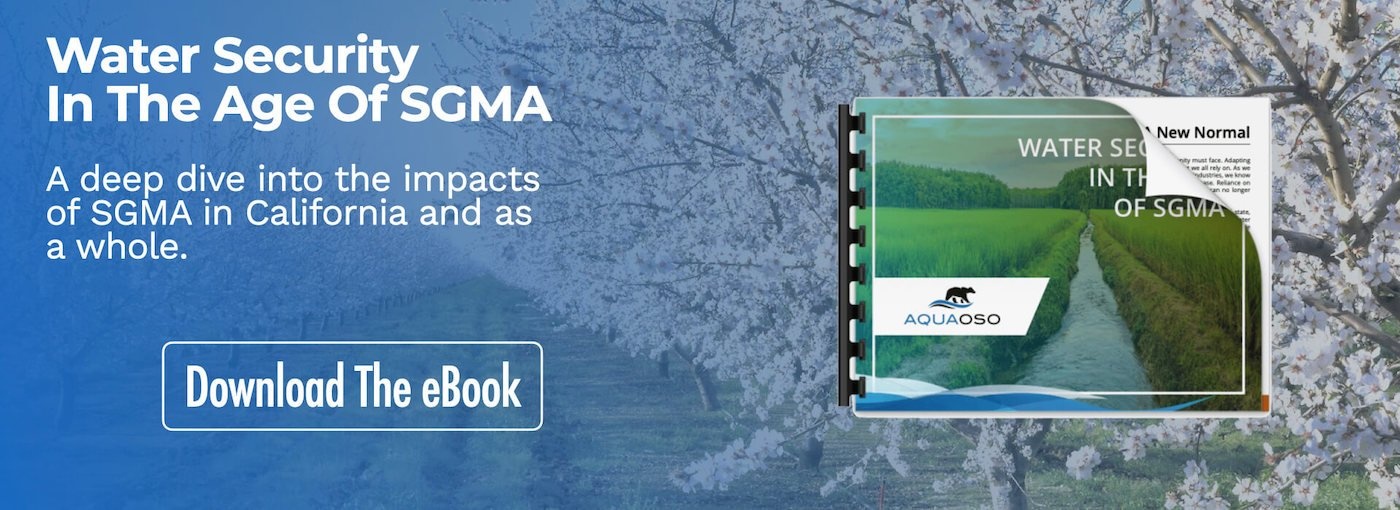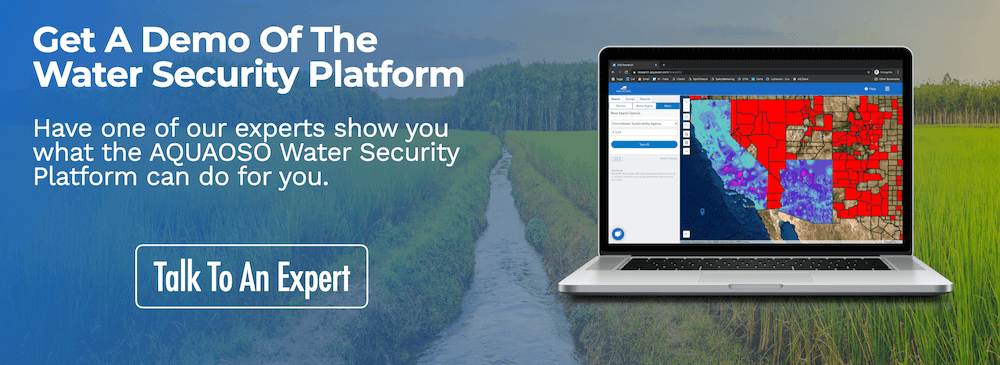How Do Land Deals Tie into Agricultural Water Risk and Resilience?

Part of our How to Conserve Water in Agriculture Guide
Land and water issues may seem like two entirely different topics, but when it comes to agricultural property/land deals, you can’t talk about one without considering the other.
In a time of water stability, lenders and investors may be able to make decisions about property without taking water risk into account. However, now that water stress/scarcity is increasing, and most of the American West is expected to face severe water stress by 2030, it’s no longer possible to make land deals without first assessing water risk.
According to the Food and Agriculture Organization of the U.N.:
“Water is necessary for most productive uses of land. In a growing number of countries … the main constraint to agricultural growth is the availability of water rather than land.”
While navigating this new reality can be a challenge, it doesn’t have to be an obstacle to smart agricultural investing. In this article, we’re going to show you why it’s so important to understand water risk, and where you can get the information you need to continue making efficient and successful land deals.
Why Water is Critical to the Value of Agricultural Land
As BlackRock puts it in their 2020 Troubled Waters report, “Water stress has financial implications” in a variety of industries:
“Companies with production facilities in water-stressed regions may face greater operating costs and insurance premiums…. In the real estate market, tenant preferences are likely to shift toward green buildings.”
And in agriculture, land and water rights are inextricably linked. Chris Peacock, Founder and CEO of AQUAOSO, explains it this way: “Water is critical to the value of agricultural land. Without sufficient water supplies, agricultural land can depreciate significantly.”
We’re already seeing this in some parts of the U.S., most notably in California’s Central Valley, where financial losses associated with reduced (or no) crop yield can reach into the billions of dollars. As Chris says, “Water risk is business risk.”
“Water is a critical asset to understand when lending or investing money to acquire farmland. Reliable access to water is the single most important variable in land deals.”
Financial institutions can have trouble getting an accurate, up-to-date picture of a borrower’s risk profile. This has a ripple effect throughout the agricultural sector, slowing down land deals and making it harder for farmers to access the resources they need to maintain their crops.
The Current State of Land Deals
The current state of global land and water markets leads to several adverse incentives that may actually increase water risk. As explained in the PNAS scientific journal:
“Despite its important impacts on crop production, food security, and rural livelihoods, water often remains hidden in the economic valuation of agricultural assets. Unlike oil, it is seldom treated as a commodity and traded in the marketplace.”
This makes it difficult to account for the value that water adds to a parcel of land, or that a lack of available water resources detracts from it. In regions without access to smart water markets, for example, there may be no way to buy and sell water rights without also selling the land associated with it, and vice-versa.
According to the International Institute for Environment and Development (IIED), “many African governments are signing away water rights for decades to large investors” that are only interested in properties with high rainfall or access to irrigation:
“Water is often critical to land deals, especially if these are made in semi-arid regions or with the intention of growing thirsty crops. Countries that have land but little water – such as the Gulf States – are already investing in semi-arid Africa and, like many other investors, are seeking to secure water rights alongside land rights.”
In the U.S., water scarcity has resulted in property values decreasing in some of the areas most affected by water stress. In parts of California, writes the William & Mary Environmental Law and Policy Review, “The specter of living on water delivered by trucks is lowering the pace of sales and the value of homes and businesses.”
Likewise, parts of the Corn Belt are experiencing high temperatures and droughts, to the point where corn may not be a viable crop in Kansas anymore. This will lead to a “precipitous decline of business and property values,” the report predicts.
How Land Deals Can Be Part of a Water-Resilient Future
How, then, can we change our approach to land deals to adapt to this new reality? One solution is to factor water risk directly into land deals, and to make this an ordinary and expected part of the appraisal and underwriting process.
This kind of due diligence is already a standard part of many other business deals. As the W&M report explains,
“Lawyers who represent purchasers have a duty to advise their clients regarding the risk of their prospective investments. [They] must know the client’s plans for the use of the property, determine whether those plans can be fulfilled, and be sure that the client diligently investigates and resolves all material matters relevant to those plans.”
The challenge is that the lenders and investors making decisions about loans aren’t in a position to ascertain the impact of water risk themselves.
“Water is really hard to understand,” says Chris Peacock of AQUAOSO. Many lenders end up relying on inefficient consultants and outdated reports – while trying to make real-time decisions. “Banks started asking us if we could help them understand the impact of water risk across their agricultural lending operations.”
Chris reports that with AQUAOSO’s Water Security Platform, it takes customers 85% less time to gather the information they need, and 50% less time to close a loan.
It isn’t just about speeding up the process and returning to the status quo, though. W&M warns about the Land Use Climate Change Bubbles – comparable to the 2008 housing bubble – that will result if we don’t take environmental factors into account.
With access to better information, says Chris, “Our customers will be able to price water risk directly into their loans. They’ll be able to share AQUAOSO’s water risk mitigation strategies directly with their customers.” And ultimately, they’ll be able to “help these borrowers become even better stewards of our land and water resources.”
You can read more about how conserving water in agriculture is important for you, financially, in our comprehensive guide.
The Bottom Line
There are no easy answers to the water stress we face, and it may take some time for markets to adjust to the road ahead. But by understanding water risk – and using that information to inform financial decisions – investors across the board will be able to make better land deals that result in more stable and sustainable land values.
If you want to learn more about how water stress is affecting lending, you can download one of our free ebooks on smart water markets and agricultural lending in California.
Or, explore one of the other regions we serve and request a demo of our Water Security Platform to find out how AQUAOSO can help you.


